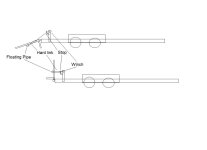Defective
Platinum Member
Bones,
Do you think you'll be able to handle a 4' steel pry bar after the surgery?
You may be able to save yourself a lot of expense & effort by learning to apply leverage to your advantage.
I've broken my back twice & done various other indignities to it. I can't lift more than about 40 pounds if it involves any kind of bending or much movement. On the other hand, I can comfortably move 5 ton steel beams around on the horses to paint them with no assist other than my beam dogs and a 4' pry bar.
Do an experiment: Attach a couple of C-clamps to the side of one of your ramps. I'd say about 1/4 - 1/3 of the length from the hinge down. Put them 3 or 4 inches apart. Now put a pry bar between them & see if you can get it to start lifting without putting any of the strain on your back. Just use your arms. The idea is to avoid bending your back at all.
Do you think you'll be able to handle a 4' steel pry bar after the surgery?
You may be able to save yourself a lot of expense & effort by learning to apply leverage to your advantage.
I've broken my back twice & done various other indignities to it. I can't lift more than about 40 pounds if it involves any kind of bending or much movement. On the other hand, I can comfortably move 5 ton steel beams around on the horses to paint them with no assist other than my beam dogs and a 4' pry bar.
Do an experiment: Attach a couple of C-clamps to the side of one of your ramps. I'd say about 1/4 - 1/3 of the length from the hinge down. Put them 3 or 4 inches apart. Now put a pry bar between them & see if you can get it to start lifting without putting any of the strain on your back. Just use your arms. The idea is to avoid bending your back at all.
